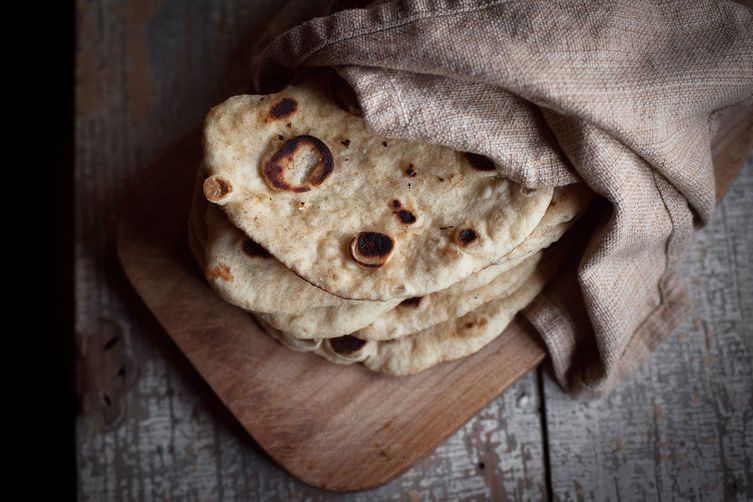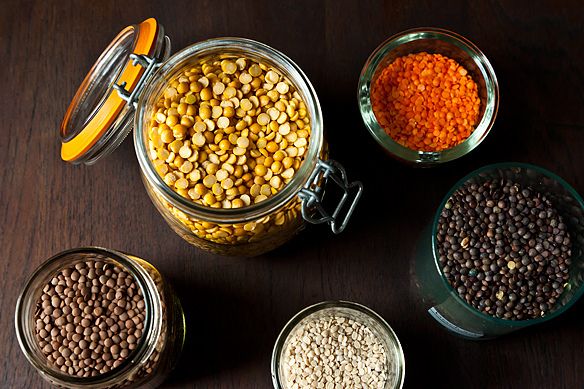
A New Way to Dinner, co-authored by Food52's founders Amanda Hesser and Merrill Stubbs, is an indispensable playbook for stress-free meal-planning (hint: cook foundational dishes on the weekend and mix and match ‘em through the week).
Order nowPopular on Food52
35 Comments
Mariam T.
March 12, 2020
North Indian cuisine is in fact much much diverse than what your write up suggests. You forgot about BBQ featuring prominently in North Indian cuisine like chicken, paneer or mutton tikka and seekh kabab. Moreover generous use of fresh coriander to top curries. Also fruit and vegetable chaat of all sorts are a prominent menu items.
Sweetberry
September 15, 2019
Great article. However, as an an ethnic Indian brought up in South East Asia and now living with the USA for the past two decades, the very mention of your caste made me cringe and threw me off guard. I tend to hear one's caste as a defining factor of one's identity only from Indians who are originally from India. The caste system is responsible for so much misery amongst the lower castes that I find that writers such as yourself can do the world a big favor by refraining from keeping this crazy tradition from thriving. It's an embarrassing man-made tradition that people like myself want no part in association. I hope you understand. It just drives me crazy to see this pop up in such a reputable online magazine. Perhaps you found it to be an important criterion to distinguish North and South Indian dishes; however, I didn't. I do admit that I'm not from India, and for that reason, that actually may be a good thing. It makes me sad that India has still a long way to to go.
Antje D.
November 2, 2016
I cook Southern Indian recipes and keep a well-stocked spice box. Do I have to get another spice box now to cook Northern Indian recipes?
Alexandra G.
July 28, 2016
While both Indian cuisines sound equally delicious, I can honestly say I don't think I've ever had anything remotely Southern Indian. I did however, save an idli recipe after watching a documentary in which a tourist in the South of India thought all the locals were saying 'Italy.' Haha.
Chef D.
November 12, 2015
the thing I love most about Indian food is the Nanna bread you get with curries :)
PRNJ
July 7, 2015
In the southern state of Kerala people usually prefer the short grained parboiled Rice ( Matta variety) which has a unique nutty flavour and nutritious than polished white long grain rice. Coconut Oil is used for all cooking purposes. Traditional breakfast consists of dishes like Puttu, Aappam, Pathiri (North Malabar) and also boiled and seasoned tapioca with fish curry. Fresh seafood is a staple on all days along the coast. Mussels ( Kallummakaya) is a delicacy in Nort Malabar. these are but a few facts about Kerala cuisine.
I_Fortuna
July 7, 2015
PRNJ - Hello, I wanted to add this info so people know the differences in rice. I found this info which supports your statement that red or matta rice is more nutritious than some others.
"Response from: Sangeetha Perumal,
Registered Member on Ammas.com
Source: This information comes from my own knowledge.
Its a good question you have asked here which helped me also to learn what exactly is the difference between these rice
As per the various websites I gone thru I came to the following conclusions
1)Matta rice and kerala red rice are same 2)Brown rice is unmilled, has only the husk removed, and retains 100% of the bran. Red rice is semi-milled, with the husk and some of the bran removed. White rice is milled and polished to remove the husk and all the bran. Unlike white rices, brown/red rices are high in fibre, have a wonderful array of nutrients, and possess properties that help control blood lipids, and blood sugar levels. 3)Similar to brown rice, red rice has undergone minimal processing, still has its bran layers and takes 45-50 minutes to cook. Brown and red rice are somewhat chewy, fiber-rich and chock-full of B vitamins— thiamin, riboflavin and niacin. Red rice also has a nutty flavor, but many find it more savory than brown rice.
The caloric density for red rice is similar to that of brown rice, so one-third cup has about 80 calories. Whether your rice is brown, red or white, one-third cup counts as one diabetic exchange—the amount of a particular food that contains about 15 grams of carbohydrate such as 5 crackers, a slice of bread or 3 cups of salad greens. But highfiber, high-carbohydrate foods like brown and red rice have been shown to improve blood lipids, blood glucose and glycated hemoglobin (Hemoglobin A1C), a longer-term measure of blood sugar control. Both have more to offer than their white rice counterpart."
http://www.ammas.com/topics/Nutrition/a137937.html
"Response from: Sangeetha Perumal,
Registered Member on Ammas.com
Source: This information comes from my own knowledge.
Its a good question you have asked here which helped me also to learn what exactly is the difference between these rice
As per the various websites I gone thru I came to the following conclusions
1)Matta rice and kerala red rice are same 2)Brown rice is unmilled, has only the husk removed, and retains 100% of the bran. Red rice is semi-milled, with the husk and some of the bran removed. White rice is milled and polished to remove the husk and all the bran. Unlike white rices, brown/red rices are high in fibre, have a wonderful array of nutrients, and possess properties that help control blood lipids, and blood sugar levels. 3)Similar to brown rice, red rice has undergone minimal processing, still has its bran layers and takes 45-50 minutes to cook. Brown and red rice are somewhat chewy, fiber-rich and chock-full of B vitamins— thiamin, riboflavin and niacin. Red rice also has a nutty flavor, but many find it more savory than brown rice.
The caloric density for red rice is similar to that of brown rice, so one-third cup has about 80 calories. Whether your rice is brown, red or white, one-third cup counts as one diabetic exchange—the amount of a particular food that contains about 15 grams of carbohydrate such as 5 crackers, a slice of bread or 3 cups of salad greens. But highfiber, high-carbohydrate foods like brown and red rice have been shown to improve blood lipids, blood glucose and glycated hemoglobin (Hemoglobin A1C), a longer-term measure of blood sugar control. Both have more to offer than their white rice counterpart."
http://www.ammas.com/topics/Nutrition/a137937.html
susan H.
May 17, 2015
leaving for two weeks in south india in november. i have a long love affair with american versions of classic indian dishes, and your article increases my enthusiasm about my up-coming trip by a factor of ten! many thanks.
Chitra A.
May 18, 2015
Thanks so much Susan and enjoy your trip! I also have a list of places to eat while in Bangalore: http://www.seriouseats.com/2013/02/snapshots-from-india-vegetarian-eats-in-bangalore.html
djamilahv
May 17, 2015
I absolutely loved this concise and clear article! I'm from Chile, and here we have a few Indian restaurants but they all offer the same. I always wondered about the differences in the complex and rich Indian cuisine, and this is a very educating first approach. Your article insinuates that there even other cuisines, and in spite of not explaining them, it leaves me with the interest to read your next writing about west, east, etc kind of cooking. Thank you! I hope to find your book in my country.
I_Fortuna
May 17, 2015
I can't think of an Indian food I don't like. It is all good! I had enjoyed it regularly before I met my hubby. Unfortunately he is really picky and his palate is not educated to Indian, Thai or Japanese foods all of which I love and he does not.
Thank you for the recipes and I hope to make these for myself at least.
The best ?curry? I ever had was in the 70's at a small takeout in Palo Alto, CA. It was a red and rather hot chicken curry and was the most delicious of any I ever had to date. Was it a butter curry? I think it had tomatoes and was creamy. Do you have a recipe for this as I have described it? I would love this recipe.
Thanks for posting this interesting article, I praise your courage for enduring the critics. : )
Thank you for the recipes and I hope to make these for myself at least.
The best ?curry? I ever had was in the 70's at a small takeout in Palo Alto, CA. It was a red and rather hot chicken curry and was the most delicious of any I ever had to date. Was it a butter curry? I think it had tomatoes and was creamy. Do you have a recipe for this as I have described it? I would love this recipe.
Thanks for posting this interesting article, I praise your courage for enduring the critics. : )
Chitra A.
May 18, 2015
Hmm what you are describing sounds like chicken tikka masala, which was actually invented in the UK, but it was closely based on a butter chicken curry from North India.
Jessin N.
May 17, 2015
cuisines of all south indian states are very different. im from kerala, my husband is half tamil..both the cuisines are different..for breakfast malayalees do eat appam, puttu, idiyappam...all rice dishes....its not all about idli n dosa n sambar..
Chitra A.
May 18, 2015
Hi Jessin, Thanks for reading and for your comment! I am very conscious of the differences in South Indian cuisines, which is why in my article I write: "Generally speaking, South Indian cooking is ...."
ame
May 15, 2015
I'm Indian, I'm from Kerala and I really appreciate this effort to highlight the diversity of Indian cuisine. It's impossible to get everything in such a short space. I follow Food52 regularly, it's such a treat to see a post on Indian cooking.
Ren
May 15, 2015
South India extends to kerala and tamil nadu. It doesn't stop at Karnataka. I hope you will make better effort next time.To all the viewers of this article, the cuisines of india varies from state to state.
Amisha G.
May 15, 2015
This article explains cuisines of India in a short and concise, easy to understand way. We all know that cuisines vary from state to state, and its quite complicated, but to be able to articulate it in a short article, Chitra has done her best to explain/clarify it shortly.
Vel
May 17, 2015
Ren -- did you read the article all the way through? Chitra states: "The nuances in Indian cuisine are even clearer when comparing the preparations of similar recipes from neighboring states, and even within communities from the same state."
I am from Tamil Nadu, and I found the article to be a great introduction for someone completely unfamiliar with the cuisine! Thanks Chitra.
I am from Tamil Nadu, and I found the article to be a great introduction for someone completely unfamiliar with the cuisine! Thanks Chitra.
Anna F.
May 14, 2015
I enjoyed the simplicity of this informative, and delicious, article. So often the diversity of Indian cuisine is lost on Americans who sum up "Indian food" as tikka masala and nana, which, as you mentioned in your article, is only the food of one region. We need more informed articles about the finer points of the cuisines of the world that get lost on the United States as part of a stereotype. I like that you included the two recipes as an illustration of how two dishes can be made different ways depending on the region. Thank you for writing this!
Angela G.
May 14, 2015
My new Indian friends invited me over for dinner last week when they heard how much I loved Indian food. They're vegetarian, and although I couldn't tell you the name of the dish that was made (even though they said it several times), I will say OH MY WORD, I'm so happy they are my friends (and so is my tummy)! I'm excited to learn more about their culture, and their cooking!
Ann L.
May 13, 2015
I love practically all Indian dishes I've had and enjoy learning more about the cuisine in this article. Would you also say northern cuisine is more dairy-based and southern more reliant on coconut/coconut-milk?
Chitra A.
May 13, 2015
Thanks so much for your comment! Dairy is used in both cuisines, but I have noticed that yogurt is included in many more dishes that my South Indian family cooks than my North Indian family. In South Indian cooking from Karnataka where my mother is from we use more fresh coconut and no coconut milk really. Coconut milk is used more in Kerala-style cooking. And yes you're right coconut is rarely cooked with in North India traditionally.






See what other Food52 readers are saying.